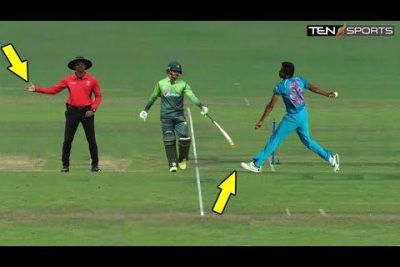Cricket, often hailed as a gentleman’s game, has witnessed its share of dramatic umpiring controversies over the years. From questionable decisions that have altered the outcome of matches to heated arguments between players and officials, the role of umpires in this beloved sport has been a subject of intense scrutiny. In this article, we delve into some of the most memorable umpiring controversies in cricket, analyzing their impact on the game and sparking a debate on the need for improved officiating in the future.
What match in cricket history is considered the most controversial?
In cricket history, the most controversial match undoubtedly belongs to the intense clash between Australia and India in 2008. This match, famously known as the ‘Monkeygate’ controversy, ignited a firestorm of debates and discussions that continue to reverberate to this day. However, it was not just the racial slurs exchanged between players that made this encounter controversial. The second Test of the 2007/08 Border-Gavaskar Trophy witnessed a shocking display of umpiring errors, with a staggering 12 decisions incorrectly given. This unprecedented level of incompetence in officiating added fuel to the already raging controversy, leaving a lasting mark on the sport’s history.
The Australia vs India match in 2008 stands as a glaring example of the most contentious moment in cricket. Beyond the infamous ‘Monkeygate’ incident, it was the umpiring blunders during the second Test of the Border-Gavaskar Trophy that amplified the controversy. With a shocking count of 12 incorrect decisions, this match showcased a level of incompetence rarely witnessed before. As cricket enthusiasts worldwide grappled with the fallout, this controversial encounter became a defining event in the sport’s narrative, forever etching its place in cricket history.
What was the reason for Steve Bucknor’s ban?
Steve Bucknor was banned from officiating in the third Test between Australia and India in Perth due to a series of incorrect decisions that had a significant impact on India’s defeat in the second Test in Sydney in January 2008. As a result, the International Cricket Council (ICC) made the decision to remove him from the match and replace him with Billy Bowden, hoping to ensure fair and accurate officiating.
What are the consequences of an umpire making an incorrect decision in cricket?
In the game of cricket, the role of an umpire is crucial in maintaining fairness. However, what happens when an umpire makes an incorrect decision? Well, if the umpire’s call is clearly proven wrong by the Decision Review System (DRS), he is obliged to overturn his decision. This ensures that the correct outcome is achieved, and justice is served on the field.
Nevertheless, there are instances where the margin of error is narrow or the third umpire’s findings are inconclusive. In such cases, it is referred to as an umpire’s call. When an umpire’s call is made, the on-field umpire’s original ruling is followed, even if it is later discovered to be incorrect. This approach aims to maintain the flow of the game, as overturning every marginal decision would disrupt the game’s natural rhythm.
Ultimately, the consequences of an umpire giving a wrong decision in cricket can be rectified through the implementation of the DRS. This technology acts as a reliable tool in ensuring fair play and reducing human error. As the game progresses, cricket continues to embrace technology to minimize the impact of incorrect decisions and uphold the integrity of the sport.
Inside the Cricket Pitch: Unmasking the Most Controversial Umpiring Moments
Inside the Cricket Pitch: Unmasking the Most Controversial Umpiring Moments
Step into the thrilling world of cricket where the bat clashes with the ball, and tensions rise with every decision made by the umpires. Unmasking the most controversial umpiring moments reveals a world filled with intense debates and heated disputes. From the infamous “ball tampering” incident to the dramatic “third umpire’s call,” these moments not only shape the outcome of matches but also ignite fierce discussions among players, fans, and experts alike. With the spotlight on the umpires, their every decision is scrutinized, and the pressure to make the right call becomes an unrelenting challenge. Inside the cricket pitch lies a battleground of controversies, where the role of the umpire holds the power to either make or break the game.
Cricket’s Hot Seat: Examining the Most Infamous Umpiring Decisions
Cricket’s Hot Seat: Examining the Most Infamous Umpiring Decisions
In the world of cricket, where split-second decisions can change the course of a match, umpiring controversies have always been a hot topic of discussion. From questionable LBW calls to controversial catches, there have been several instances that have left fans and players alike scratching their heads. One such infamous decision was the ‘ball tampering’ scandal during the 2018 South Africa vs Australia series, where Australian cricketers were caught using sandpaper to alter the condition of the ball. This incident not only led to severe consequences for the players involved but also sparked a global debate on the integrity of the game and the role of umpires in maintaining fair play. As the cricketing world continues to evolve, it becomes crucial to examine these infamous umpiring decisions and their impact on the sport, ensuring that fairness and transparency remain at the heart of the game.
Decoding Cricket’s Umpire Dilemmas: Unveiling the Shocking Controversies
Decoding Cricket’s Umpire Dilemmas: Unveiling the Shocking Controversies
In the world of cricket, umpiring decisions have always been a topic of intense debate and controversy. From close calls to questionable judgments, these dilemmas have left fans and players scratching their heads. However, beneath the surface lies a web of shocking controversies that have rocked the cricketing world. One such instance was the infamous “ball tampering” scandal, where a team was caught altering the condition of the ball to gain an unfair advantage. This revelation not only tarnished the reputation of the players involved but also raised serious questions about the integrity of the game. These umpire dilemmas, far from being mere mistakes, have unveiled a darker side of cricket that fans can no longer ignore.
As the spotlight shines brighter on cricket’s umpire dilemmas, it becomes evident that these controversies are not isolated incidents but rather a recurring pattern. Another shocking incident that came to light was the match-fixing scandal, where umpires were found to be involved in manipulating the outcome of a game. This revelation sent shockwaves through the cricketing community, as it shattered the trust that fans had in the integrity of the sport. The ripple effect of these controversies has been profound, prompting cricketing authorities to reevaluate the system and implement stricter regulations to ensure fair play. The unraveling of these shocking controversies has forced the cricketing world to confront its umpire dilemmas head-on, demanding transparency and accountability like never before.
In the ever-evolving world of cricket, umpiring controversies continue to spark intense debates among players, fans, and pundits alike. As technology advances, the need for accurate decisions becomes more pronounced, demanding a balance between the human element and the use of innovative tools. While umpiring errors can frustrate and disappoint, they also serve as a reminder that cricket is a game played by imperfect beings. As the sport strives for perfection, it is essential to appreciate the challenges faced by umpires and work collaboratively towards refining the system, ensuring that fairness and integrity remain at the heart of every decision made on the field.


